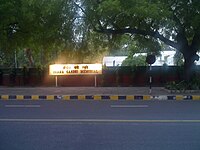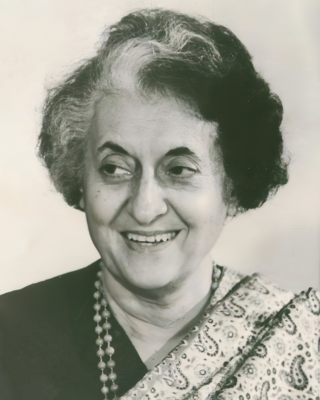
Indira Gandhi was an Indian politician who served as the third Prime Minister of India from 1966 to 1977 and again from 1980 until her assassination in 1984. She was India's first and, to date, only female prime minister, and a central figure in Indian politics as the leader of the Indian National Congress. Gandhi was the daughter of Jawaharlal Nehru, the first prime minister of India, and the mother of Rajiv Gandhi, who succeeded her in office as the country's sixth prime minister. Furthermore, Gandhi's cumulative tenure of 15 years and 350 days makes her the second-longest-serving Indian prime minister after her father. Henry Kissinger described her as an "Iron Lady", a nickname that became associated with her tough personality since her lifetime.

The Khalistan movement is a separatist movement seeking to create a homeland for Sikhs by establishing an ethno‐religious sovereign state called Khalistan in the Punjab region. The proposed boundaries of Khalistan vary between different groups; some suggest the entirety of the Sikh-majority Indian state of Punjab, while larger claims include Pakistani Punjab and other parts of North India such as Chandigarh, Haryana, and Himachal Pradesh. Shimla and Lahore have been proposed as the capital of Khalistan.
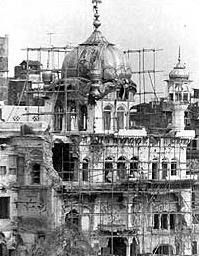
Operation Blue Star was an Indian Armed Forces operation between 1 and 10 June 1984 to remove Sikh militant Jarnail Singh Bhindranwale and other Sikh separatists from the buildings of the Golden Temple, the holiest site of Sikhism.
Events in the year 1984 in the Republic of India.

Jarnail Singh Bhindranwale was a Sikh militant. He was the leading figure of the Khalistan movement, although he did not personally advocate for a separate Sikh nation.

Giani Zail Singh was an Indian politician from Punjab who served as the seventh president of India from 1982 to 1987 and 9th Chief Minister of Punjab. He was the first Sikh to become president.

Babbar Khalsa International, better known as Babbar Khalsa, is a Sikh militant organisation that aims to create an independent Sikh nation of Khalistan in the Indian and Pakistani states of Punjab. It has used armed attacks, assassinations and bombings in aid of that goal, and is deemed to be a terrorist entity by various governments. Besides India, it operates in North America and Europe, including Scandinavia.

Beant Singh was one of the bodyguards along with Satwant Singh, who assassinated the Prime Minister of India, Indira Gandhi, at her New Delhi residence on 31 October 1984.
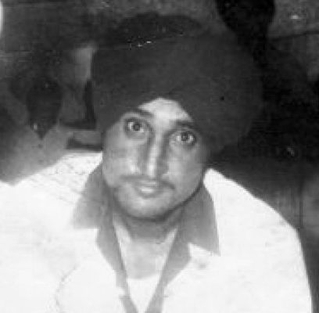
Satwant Singh was one of the bodyguards, along with Beant Singh, who assassinated the Prime Minister of India, Indira Gandhi, at her New Delhi residence on 31 October 1984. His attacks were in retaliation of Indira Gandhi's Operation Blue Star.

The Insurgency in Punjab was an armed campaign by the militants of the Khalistan movement from the mid-1980s to the mid-1990s. Economic and social pressures driven by the Green Revolution prompted calls for Sikh autonomy and separatism. This movement was initially peaceful, but foreign involvement and political pressures drove a heavy handed response from Indian authorities. The demand for a separate Sikh state gained momentum after the Indian Army's Operation Blue Star in 1984 aimed to flush out militants residing in the Golden Temple in Amritsar, a holy site for Sikhs. Terrorism, police brutality and corruption of the authorities greatly exacerbated a tense situation. By the mid-1980s, the movement had evolved into a militant secessionist crisis due to the perceived indifference of the Indian state in regards to mutual negotiations. Eventually, more effective police and military operations, combined with a policy of rapprochement by the Indian government and the election loss of separatist sympathizers in the 1992 Punjab Legislative Assembly election, largely quelled the rebellion by the mid-1990s.

Kehar Singh was an Assistant in the erstwhile Directorate General of Supply and Disposal, New Delhi, and was tried and executed for conspiracy in the plot of the Indira Gandhi assassination, carried out by Satwant Singh and Beant Singh. He was hanged in Tihar Jail on 6 January 1989. Beant Singh was the nephew of Kehar Singh. The assassination was "motivated" by Operation Blue Star.
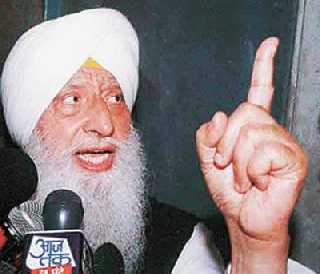
Jagjit Singh Chohan was a major Sikh leader of the Khalistan movement that sought to create a sovereign Sikh state in the Punjab region of the Indian subcontinent. Chohan established the Council of Khalistan at Anandpur Sahib on 12 April 1980 and became its first self‐styled president.

Harchand Singh Longowal was the President of the Akali Dal during the Punjab insurgency of the 1980. He had signed the Punjab accord, also known as the Rajiv-Longowal Accord along with Rajiv Gandhi on 24 July 1985. The government accepted most of the demands of Akali Dal who in turn agreed to withdraw their agitation. Less than a month after signing the Punjab accord, Sant Longowal was assassinated by Gyan Singh Leel and Jarnail Singh Halvara.
Avtar Singh Atwal was a Deputy Inspector General of the Punjab Police. He was murdered by an unknown follower of Jarnail Singh Bhindranwale on the steps of Golden temple while leaving after prayers on 25 April 1983 His murder set in motion a chain of events that led to the commencement of Operation Blue Star. He was a posthumous recipient of the President's Police Medal for Gallantry.

The 1984 anti-Sikh riots, also known as the 1984 Sikh massacre, was a series of organised pogroms against Sikhs in India following the assassination of Indira Gandhi by her Sikh bodyguards. Government estimates project that about 2,800 Sikhs were killed in Delhi and 3,350 nationwide, whilst other sources estimate the number of deaths at about 8,000–17,000.
The Dharam Yuddh Morcha was a political movement launched on 4 August 1982, by the Akali Dal in partnership with Jarnail Singh Bhindranwale, with its stated aim being the fulfillment of a set of devolutionary objectives based on the Anandpur Sahib Resolution.

Kaum De Heere is a 2014 Indian Punjabi-language biographical film by Ravinder Ravi based on the lives of Satwant Singh, Beant Singh and Kehar Singh, who assassinated Indira Gandhi, the Prime Minister of India in 1984.

The 1978 Sikh–Nirankari clash occurred between the Sant Nirankari Mission and Sikhs of Damdami Taksal and Akal Kirtani Jatha on 13 April 1978 at Amritsar, Punjab, India. Sixteen people—thirteen traditional Sikhs and three Nirankari followers—were killed in the ensuing violence, occurring when some Akhand Kirtani Jatha and Damdami Taksal members led by Fauja Singh protested against and tried to stop a convention of Sant Nirankari Mission followers. This incident is considered to be a starting point in the events leading to Operation Blue Star and the 1980s insurgency in Punjab.
Krishna Prasad Mathur is an Indian physician who was the personal physician to Indira Gandhi, the former prime minister of India. He was one of the last few people to meet her before the she was assassinated by Beant Singh and Satwant Singh on 31 October 1984.

Surinder Singh Sodhi was a Sikh militant known for being the chief bodyguard, chief hitman, transport minister, and right-hand man of Jarnail Singh Bhindranwale.

